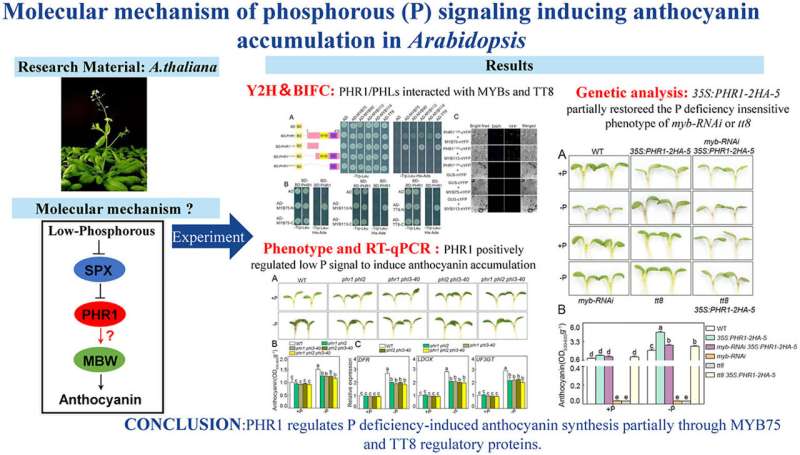This article has been reviewed according to Science X's editorial process and policies. Editors have highlighted the following attributes while ensuring the content's credibility:
fact-checked
trusted source
proofread
Study reveals how phosphorous deficiency induces anthocyanin accumulation in plants

Anthocyanins are one kind of natural pigments commonly found in plants and can act as metabolic markers of nutrient deficiency, especially phosphorous (P) deficiency. Although anthocyanin biosynthesis has been well studied, the molecular mechanism of how plants respond to environmental stresses, such as P deficiency, via anthocyanin synthesis has been rarely reported.
In a study published in Plant Physiology and Biochemistry, researchers from the Xishuangbanna Tropical Botanical Garden (XTBG) of the Chinese Academy of Sciences explored the biological functions of phosphate starvation response1 (PHR1) in P deficiency-induced anthocyanin biosynthesis, by using molecular and genetic methods.
The researchers firstly investigated the anthocyanin accumulation of anthocyanin synthesis deficient mutants of Arabidopsis. Using quantitative real-time Polymerase Chain Reaction (qRT-PCR) analysis, they demonstrated that P deficiency could induce anthocyanin accumulation, and the progress depended on the essential proteins of anthocyanin synthesis.
They then identified possible physical interactions between P-deficiency signaling central proteins and core components of the anthocyanin synthesis pathway by yeast two-hybrid analysis and found that the P signaling core PHR1 transcription factor interacted with the anthocyanin synthesis key protein.
Further phenotypic analysis showed that PHR1/PHLs (homologous of PHR1) positively regulated P deficiency-induced anthocyanin accumulation.
The study indicates that PHR1 and MYB-bHLH-WD40 (MBW) complexes form protein complexes that directly mediated the process of P starvation-induced anthocyanin accumulation, providing a new mechanistic understanding of how P-deficient signaling depends on endogenous anthocyanin synthesis pathway to promote anthocyanin accumulation in Arabidopsis.
"Our study may provide a theoretical basis for the intrinsic connection between exogenous nutrient signals and endogenous anthocyanin synthesis signaling," said Hu Yanru of XTBG.
More information: Huiqiong Li et al, Molecular mechanism of phosphorous signaling inducing anthocyanin accumulation in Arabidopsis, Plant Physiology and Biochemistry (2023). DOI: 10.1016/j.plaphy.2023.01.029
Provided by Chinese Academy of Sciences

















